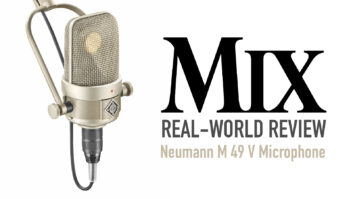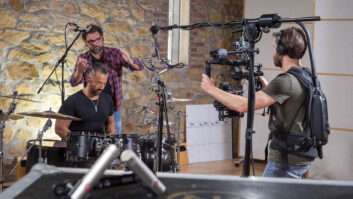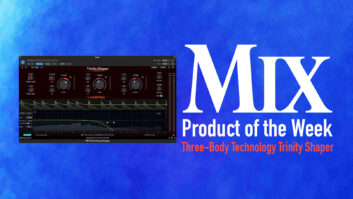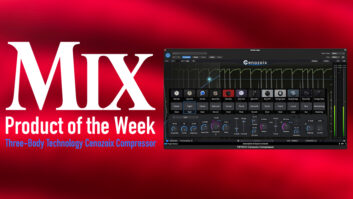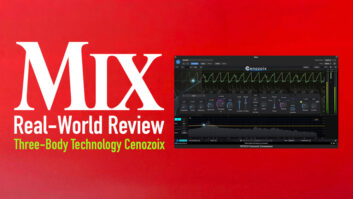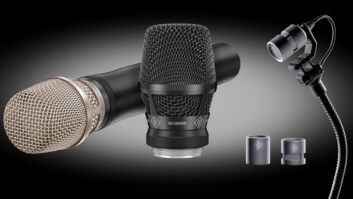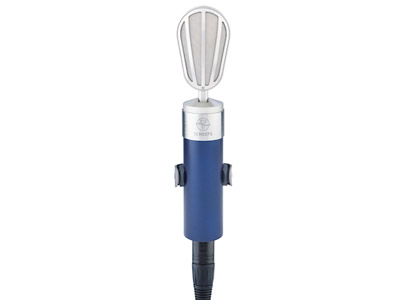
While great ribbon mics are my favorites for unique flavor, they don’t always fit into every application—that’s where condenser mics shine. For vocals, over a drum kit, as room mics, close up on an acoustic guitar, piano or Leslie cabinet, they expertly cover the gamut. When contemplating a new mic purchase, you always want something you can grow with, meaning it will not only retain its value but its sonic character will stand the test of time.
The three microphones tested here fall into that category. They are all solid players that bring their own taste to the table, are built to last, and in the case of the Myrinx mods, offer something completely new. I powered the three mics tested here with a variety of preamps, from classic Neve 1073s to the Moon 3500MP, a super-clean, audiophile-bred preamp from Simaudio in Montreal.
Schoeps V4U
The inspiration for the look of the new small-diaphragm, fixed cardioid Schoeps V4U came from Schoeps’ third microphone ever made—the CM51/ 3, manufactured in 1951. But it’s not all about retro chic, as Schoeps states: “The 33mm beveled collar around the diaphragm causes its directivity to increase steadily and smoothly at high frequencies, as in a large-diaphragm microphone.” The head can be angled up to 20 degrees front to back, making it easy to fine-tune the placement without turning the stand or mount. SPL is rated at 144 dB, but I never got close to that, nor did the mic ever sound remotely challenged at the output—it was always clear and clean. The capsule is elastically suspended to reduce vibration and the output is a newly developed bridge-type transformerless circuit.
The first application of the mic was on a male vocalist. The V4U is marketed as a vocal mic, but in repeated tests I found that it sounded better elsewhere. Side by side with a vintage U47 as a “B” choice, the V4U sounded great. It was full-bodied and had an even feel to the frequency range on this vocalist, who had a booming voice with a big low end. The main difference between the two mics was at the top. The V4U was a lot more present in the sibilant range, which was overly bright for my taste. I tried to naturally EQ the vocal by turning the mic 90 degrees off-axis, but it was still top-heavy. We recorded a verse and chorus with both mics through the same chain—a Moon 3500MP preamp and an LA2A using moderate to heavy gain reduction at the peaks. After a purposefully blind playback session with the artist, we all decided that the U47 had it over the V4U.
Next, I had the V4U over a Gretsch Gold Sparkle drum kit, powered by a Neve 1073 preamp in a medium-size overdub booth at Blackbird Studio A. It was used as a center overhead flanked by two Telefunken 251s. The V4U gave a great overall picture of the kit, beautifully clear cymbal ring, hyper-real stick hits on snare, toms and cymbals. The bright top of the V4U made the perfect pairing with the 251s. It brought an intimacy to the overall picture that was not there with just the two overheads.
On acoustic guitar, fiddle and mandolin, this mic was in its element. By itself or paired and blended with a Royer 121 on the fiddle and mando, it was, for lack of a better word, “perfect.” The same was true when used as a single mic outside a Yamaha C3 grand piano. The attack of the hammers on the strings, even at a distance, was just right, while the rest of the frequency range was equally and realistically represented.
Calling the V4U a “Studio Vocal Microphone” as Schoeps does is misrepresenting its range and unnecessarily underestimating its potential as a great all-around studio stalwart. If you’re looking for a vocal mic, look some more, but if you want a great go-to condenser that can bring the best when used in a wide range of applications, the V4U is your huckleberry.

Neumann TLM 107
The TLM 107 is Neumann’s newest large-diaphragm condenser and takes the company’s tech up a notch. The compact body and grille design maintains the company’s legacy look, and while others have created mics with logic circuits and lights, it’s new to Neumann. And it’s not just there to bring the bling. When the mic lights up, it ticks one troubleshooting box that is always a question when there’s no output at the end of the signal chain: If the light is on, phantom power is home.
Control for the plentiful features is on a slick and tiny joystick at the back of the mic that Neumann calls a navigation switch. Pushing and kicking the stick up, left and right, toggles through the five polar patterns: omni, wide-cardioid, cardioid, hypercardioid and figure-8. You can also switch between no pad, -6dB and -12dB, and adjust the roll-off from none to a sloped attenuation at 40 or 100 Hz. The mic comes with a swivel mount; optional accessories include an EA 4 elastic mount, two phantom-power battery packs or wired power supply.
This mic excelled in all but a few applications. A pair used as far room mics in Blackbird’s Studio A brought out the best of a Craviotto Drum Kit when placed 10 feet back and up about 8 feet from the floor. Highly placed in an iso booth above a fiddle, paired with a Royer 121, was beautiful. The Royer brought out the woody body of the instrument without being too “real,” while the TLM 107 brought out the detail of the instrument just enough when tucked in under the Royer in the mix.
On acoustic guitar the pair of TLM 107s put the player right in the room with the speakers. It was very easy to go in and switch the patterns, and it was great to have the confidence of knowing that the mic was getting P48 when the lights were on.
Other applications included the pair over a drum kit, on a male vocal and on a bass cabinet, with only the latter being a poor choice. In this case, the amp was an Ampeg B15, and while the TLM 107 sounded okay, it just didn’t bring the best of that amp to the session. For most sessions we’ve used an AKG D112 or an EV RE-20 in this application, and that is where we ended up here.
We had the opportunity to bench test the TLM 107 with our Stanford Research SR-1 audio analyzer (available for download at mixonline.com). The tests reflected Neumann’s own published tests.
In my work I use many Neumann mics, new and old, and the TLM 107 represents the best of what Neumann produces—sonic parity with their legacy mics, plus innovation. The navigation switch is an excellent way to switch patterns, roll-off and pad, plus it gives you phantom-power confidence. Add to that the fair price, and you have a mic that can’t be ignored when looking for an investment you can grow with.

Myrinx Mods
Myrinx is a brand new company out of Switzerland that offers a different take on mic design and implementation. (The company also makes high-end cables under the VOVOX name.) Myrinx’s “product” is to modify existing microphones. The company’s current, and expanding, product line comprises five models: the Brauner Phantom and VM1 tube mic; Microtech Gefell M930; Neumann U87; and Pearl CC22.
What Myrinx promises to do is improve the microphone beyond its manufacturer specs by completely renovating each unit. You provide the mic, Myrinx does the mod. Myrinx’s Jürg Vogt described the approach to me: “Imagine you could listen to a capsule without a housing, like it would float in space, and listen to the signal coming from the capsule directly after the PCB—with no cables in between. That’s the ideal we try to approximate.”
To accomplish this, Myrinx replaces all internal wiring with purpose-built, solid-core, ultra-pure copper wires coated with a mesh of natural fibers (no plastic coating) from VOVOX. Next, they remove all unnecessary connectors, soldering the connecting cable directly to the PCB, and then separate the shielding and audio ground as much as possible. The metal housing is replaced by European walnut internally shielded with copper foil. Wood has been chosen because it is non-conductive, won’t hold an electrostatic charge, is a poor resonator, and has little interaction with the electric signal in the microphone. The unique, and replaceable, grille has no parallel surfaces and is made from organic lignin fibers, which is infinitely irregular, has open cells for excellent transmission of audio waves, and is rigid, non-resonant, and durable. Beneath the grille is a high-precision metal grid designed and made in Switzerland.
For this review, I had a copy of a Brauner Phantom that had been Myrinx-ised. It came in an attractive wooden box with a space for the mic, a Rycote universal mount, and a wind-around channel to hold the integrated cable. The mic is incredibly light and attractive. The lignin fiber top slides off with some effort, meaning it’s not easy to lose and can be user-replaced after some wear. To me this is a bonus when you’re using the product around a variety of singers. Not only is it cleaner, it makes you wonder what gets into other mics where you can’t remove and replace the grille.
I’m a big Brauner mic fan. They make products that sound unique and are great go-to mics around the studio. The pair of Myrinx Phantoms I tested were no exception. On lead vocals, acoustic guitar, over a drum kit, and on acoustic piano they were excellent and vacant at the same time. Hyper-reality to me means that a mic and signal chain is not adding color to the listening experience. The Myrinx Phantoms, powered by the Moon 3500MP dual channel preamp, provided this. I used the Phantoms in combination on a male lead vocal and acoustic guitar on the same project. The tracks were clean, clear, and gave me back just what was happening at the performer. While this approach doesn’t work for all types of music, it’s something you want to have in your bag of tricks when that situation arises. The pair over a drum kit, or placed back from a kit at knee height about 9 feet, offered a great rendition of the drums close and far—beautiful.
As an extra case study, I had two Brauner VM-1s, one pre and one post Myrinx. You can see the comparison tests we ran on these two using our Stanford Research SR-1 audio analyzer. Across most patterns, the Myrinx VM-1 exhibited 1-2dB hotter output in the 100Hz and 4-5kHz range. In some cases, this became less evident off axis. Download the reports to see the analysis firsthand at 0, 90, and 180 degrees.
So does the Myrinx concept translate to the end product? Is it better? The bench tests of the VM-1s show that there is improvement in two critical ranges where you could argue that warmth and intelligibility is enhanced. But I’ve never “heard” a great bench test, and as all things in art, life, and audio, beauty is in the eye of the beholder, so you should hear it for yourself. I loved the tracks recorded with the Myrinx Phantom mics. They were the epitome of high-end recording. When I use the Moon 3500MP in a signal chain, I know from experience that what I’m hearing is not being colored by the preamp—in this case the mic and the preamp were doing the same “hands-off” dance to my ears. Myrinx has a new idea and it’s worth a listen.
Product Summary
COMPANY: Schoeps
PRODUCT: V4U
WEBSITE:www.schoeps.de
PRICE: $2,999; $3,069 with Rycote Lyre shock-mount
PROS: Excels across a range of applications.
CONS: Upper frequencies overly present on-axis.
Product Summary
COMPANY: Neumann
PRODUCT: TLM 107
WEBSITE:www.neumannusa.com
PRICE: $1,699.99
PROS: Sonically excellent, slick navigation switch for toggling pattern, pad and rolloff.
CONS: Flat response can limit its use in “personality” applications (bass cabinet).
Product Summary
COMPANY: Myrinx
PRODUCT: Myrinx Phantom
WEBSITE:www.myrinx.ch
PRICE: FET Mod $1,770; Tube Mod $2,430
PROS: Hyper-real, no-color microphone.
CONS: Price may be out of range for some.
